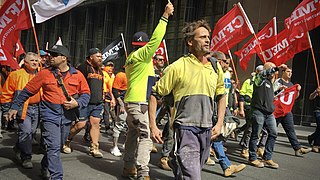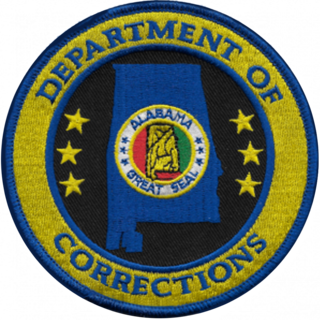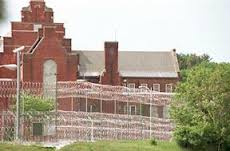
Strike action, also called labor strike, labour strike, or simply strike, is a work stoppage caused by the mass refusal of employees to work. A strike usually takes place in response to employee grievances. Strikes became common during the Industrial Revolution, when mass labor became important in factories and mines. As striking became a more common practice, governments were often pushed to act. When government intervention occurred, it was rarely neutral or amicable. Early strikes were often deemed unlawful conspiracies or anti-competitive cartel action and many were subject to massive legal repression by state police, federal military power, and federal courts. Many Western nations legalized striking under certain conditions in the late 19th and early 20th centuries.

The prison-industrial complex (PIC) is a term, coined after the "military-industrial complex" of the 1950s, used by scholars and activists to describe the relationship between a government and the various businesses that benefit from institutions of incarceration.

A chain gang or road gang is a group of prisoners chained together to perform menial or physically challenging work as a form of punishment. Such punishment might include repairing buildings, building roads, or clearing land. The system was notably used in the convict era of Australia and in the Southern United States. By 1955 it had largely been phased out in the U.S., with Georgia among the last states to abandon the practice. North Carolina continued to use chain gangs into the 1970s. Chain gangs were reintroduced by a few states during the "get tough on crime" 1990s: in 1995 Alabama was the first state to revive them. The experiment ended after about one year in all states except Arizona, where in Maricopa County inmates can still volunteer for a chain gang to earn credit toward a high school diploma or avoid disciplinary lockdowns for rule infractions.

Incarceration in the United States is a primary form of punishment and rehabilitation for the commission of felony and other offenses. As of January 2023, the United States has the second largest prison population in the world, and the sixth highest per-capita incarceration rate. One out of every 5 people imprisoned across the world is incarcerated in the United States. In 2018, the United States had the highest incarceration rate in the world, with 698 people incarcerated per 100,000; this includes the incarceration rate for adults or people tried as adults. Prison, parole, and probation operations generate an $81 billion annual cost to U.S. taxpayers, with an additional $63 billion for policing. Court costs, bail bond fees, and prison phone fees generate another $38 billion in individual costs.

The rights of civilian and military prisoners are governed by both national and international law. International conventions include the International Covenant on Civil and Political Rights; the United Nations' Minimum Rules for the Treatment of Prisoners, the European Committee for the Prevention of Torture and Inhuman or Degrading Treatment or Punishment, and the Convention on the Rights of Persons with Disabilities.

Penal labour is a term for various kinds of forced labour which prisoners are required to perform, typically manual labour. The work may be light or hard, depending on the context. Forms of sentence involving penal labour have included involuntary servitude, penal servitude, and imprisonment with hard labour. The term may refer to several related scenarios: labour as a form of punishment, the prison system used as a means to secure labour, and labour as providing occupation for convicts. These scenarios can be applied to those imprisoned for political, religious, war, or other reasons as well as to criminal convicts.

William C. Holman Correctional Facility is an Alabama Department of Corrections prison located in Atmore, Alabama. The facility is along Alabama State Highway 21, 9 miles (14 km) north of Atmore in southern Alabama.

Contemporary slavery, also sometimes known as modern slavery or neo-slavery, refers to institutional slavery that continues to occur in present-day society. Estimates of the number of enslaved people today range from around 38 million to 46 million, depending on the method used to form the estimate and the definition of slavery being used. The estimated number of enslaved people is debated, as there is no universally agreed definition of modern slavery; those in slavery are often difficult to identify, and adequate statistics are often not available. The International Labour Organization estimates that, by their definitions, over 40 million people are in some form of slavery today. 24.9 million people are in forced labor, of whom 16 million people are exploited in the private sector such as domestic work, construction or agriculture; 4.8 million persons in forced sexual exploitation, and 4 million persons in forced labour imposed by state authorities. An additional 15.4 million people are in forced marriages.

A prison, also known as a jail, gaol, penitentiary, detention center, correction center, correctional facility, lock-up, hoosegow or remand center, is a facility in which inmates are confined against their will and usually denied a variety of freedoms under the authority of the state as punishment for various crimes. Prisons are most commonly used within a criminal justice system: people charged with crimes may be imprisoned until their trial; those pleading or being found guilty of crimes at trial may be sentenced to a specified period of imprisonment. In simplest terms, a prison can also be described as a building in which people are legally held as a punishment for a crime they have committed.

The Alabama Department of Corrections (ADOC) is the agency responsible for incarceration of convicted felons in the state of Alabama in the United States. It is headquartered in the Alabama Criminal Justice Center in Montgomery.

Penal labor in the United States is explicitly allowed by the 13th Amendment of the U.S. Constitution: "Neither slavery nor involuntary servitude, except as a punishment for crime whereof the party shall have been duly convicted, shall exist within the United States, or any place subject to their jurisdiction." The state can only work an inmate if he is sentenced to labor. Ref is Watson vs Graves 1990 note 7. Unconvicted detainees awaiting trial cannot be forced to participate in labor programs in prison as this would violate the Thirteenth Amendment.
The Free Alabama Movement is an inmates rights group based in the United States. With the Incarcerated Workers Organizing Committee, the Free Alabama Movement has organized the 2016 U.S. prison strike that involved an estimated 24,000 prisoners in 24 states, the largest prison strike in U.S. history. The strike began on September 9, 2016, the 45th anniversary of the Attica Prison uprising.

TheIncarcerated Workers Organizing Committee (IWOC) is a prison-led section of the Industrial Workers of the World. Its purpose is 'a union for the incarcerated,' with the goal of abolishing prison slavery, as well as fighting to end the exploitation of working-class people around the world.

The August Rebellion refers to the August 28, 1974 uprising at the Bedford Hills Correctional Facility for Women, a New York State prison in Bedford Hills in the Town of Bedford, Westchester County, New York, United States. In August 1974, about 200 women imprisoned at Bedford Hills rebelled, taking over parts of the prison, in protest of the inhumane treatment of Carol Crooks. A subsequent civil-action lawsuit, ruled in the inmates favor, led to greater protections of Fourth Amendment rights for incarcerated people.
The 2018 U.S. prison strike was a series of work stoppages and hunger strikes in prisons across the United States that began on August 21 and ended on September 9. The strike was conducted at least in part in response to the April 2018 prison riot at Lee Correctional Institution, which killed seven inmates and was the deadliest prison riot in the U.S. in the past 25 years.

Kevin "Rashid" Johnson is a revolutionary, writer, artist, social activist, founding member of the New Afrikan Black Panther Party, founding member of the Revolutionary Intercommunal Black Panther Party, member of the Incarcerated Workers Organizing Committee, and prisoner in the Ohio Department of Rehabilitation and Correction.

Strikes occurred during the COVID-19 pandemic due to many factors including: hazard pay or low pay, unsafe working conditions, inability to pay rent. These strikes are separate from the various protests that occurred over responses to the pandemic.
Paid prison labour refers to the participation of convicted prisoners in either voluntary or mandatory paid work programs.
Prisoners' Justice Day is a solidarity movement that takes place annually on August 10. The movement began in Canada in 1974 in support of prisoners’ rights and to remember all the people who have died of unnatural deaths while incarcerated. The first Prisoners' Justice Day was held at the Millhaven Institution on August 10, 1975, on the first anniversary of Edward Nolan's death. In addition to a day of mourning, six prisoners took part in an eighteen-day hunger strike. In 1976, August 10 was recognized as a memorial day where prisoners would strike in opposition to the use of solitary confinement and to protest inmate conditions within the Prison System by going on a one-day hunger strike and refusing to work.
The 2010 Georgia prison strike was a prison strike involving prisoners at 7 prisons in the U.S. state of Georgia. The strike, organized by the prisoners using contraband cell phones, began on December 9 and ended on December 15. It was reported at the time to be the largest prison strike in United States history and was followed by similar strikes in several other states, as well as nationwide strikes several years later, in 2016 and 2018.













